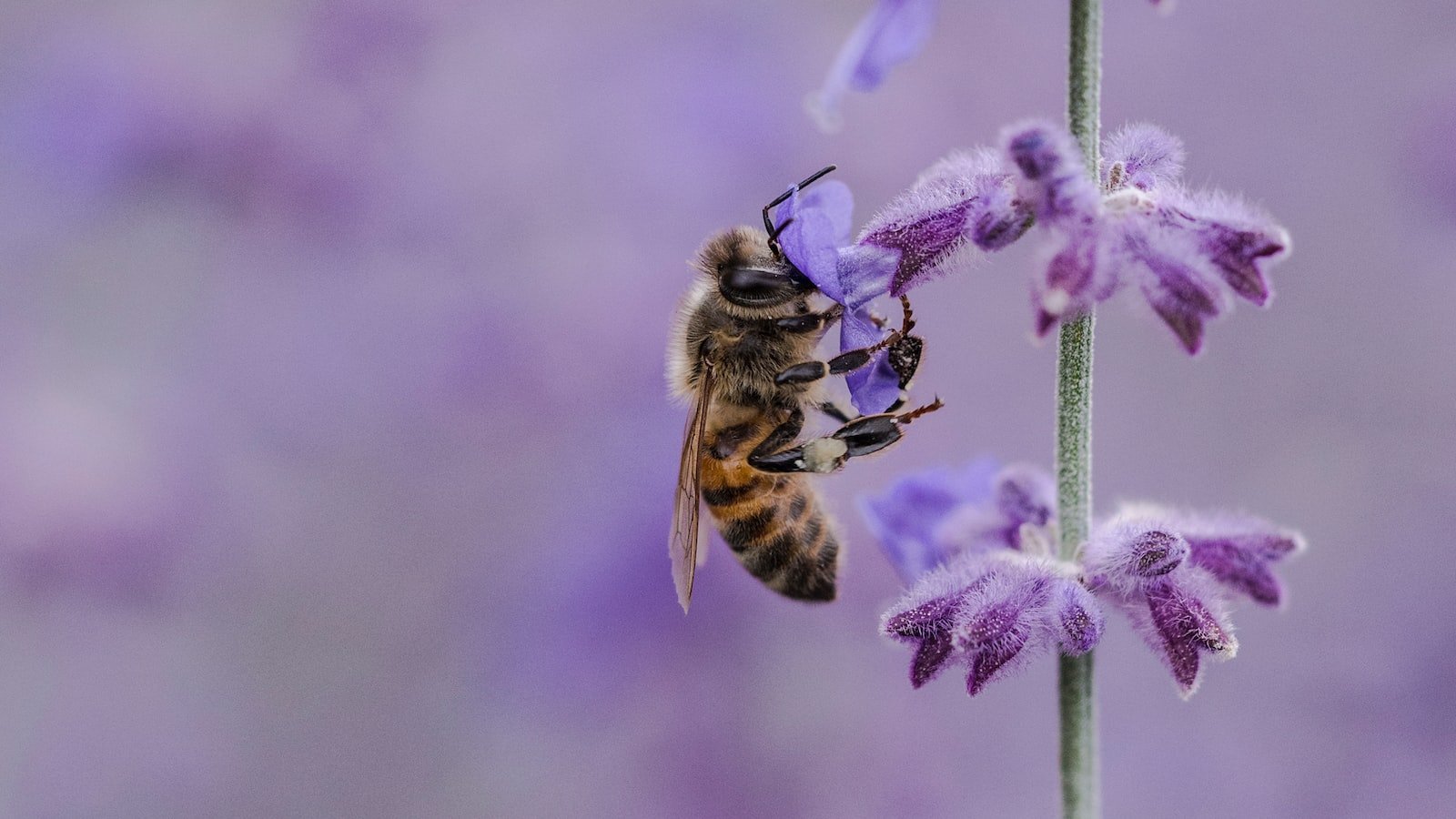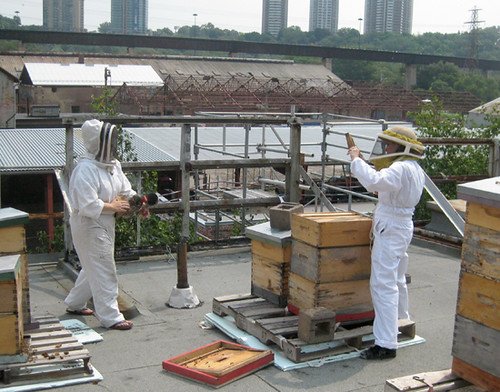In the bustling concrete jungles where tall skyscrapers reach for the clouds, and the cacophony of car horns fills the air, an unlikely symphony is now being orchestrated by some of nature’s tiniest architects: urban bees. These resilient creatures have found their place amidst the hustle and bustle of city life, creating thriving colonies that not only survive but thrive against all odds. If you, too, have been captivated by the beauty and importance of these incredible pollinators, then this article is your guide to nurturing a thriving urban bee colony. With seven essential tips, we will unlock the secrets to creating an oasis for bees in the heart of our concrete kingdoms, fostering harmony and nature in the urban landscape. So, prepare to embark on a journey that will not only benefit our buzzing companions but also enrich our own lives by reconnecting us with the wonders of the natural world.
Table of Contents
- Creating a Buzzworthy Urban Bee Colony
- Setting Up an Ideal Urban Beehive Environment
- Ensuring Abundant Food Sources for a Thriving Urban Bee Colony
- Implementing Effective Pest Management Strategies
- Promoting a Safe and Harmonious Urban Environment for Bees
- Q&A
- Wrapping Up

Creating a Buzzworthy Urban Bee Colony
Are you ready to make a beeline for urban beekeeping? Transforming your backyard into a buzzing haven for honeybees is not only an eco-friendly endeavor but also a rewarding and educational experience. Here are some essential steps to get started on your path to cultivating a thriving urban bee colony:
- Research and Planning: Begin by gaining insights into the needs of honeybees and the regulations in your city regarding beekeeping. Research the different types of honeybee breeds that thrive in urban environments and consider how pollinator-friendly plants can enhance the surroundings for your buzzing companions.
- Location, Location, Location: Choose a suitable spot for your hive, ensuring it has access to abundant sunlight, water sources, and diverse flora nearby. Create a safe and secure environment by fencing off the area and providing a clean and stable foundation for the hive.
- Setting Up the Hive: Select a beehive design that suits your preferences and available space. Whether you opt for Langstroth, top-bar, or Warre hive, make sure to assemble and set it up correctly, providing a comfortable home for the bees to thrive in.
- Obtain Bees: Purchase a package of bees or acquire a nucleus colony from a reputable bee supplier. Take necessary precautions while transferring bees to their new hive, ensuring minimal stress for the delicate insects.
- Beekeeping Techniques: Familiarize yourself with proper hive management techniques, including regular inspections, monitoring the health of the colony, and addressing potential issues like pests and diseases promptly.
By following these steps and embracing the world of urban beekeeping, you are not only supporting the critical role bees play in our ecosystem but also fostering a thriving community of honey-makers right at your doorstep. So, put on your beekeeper hat and get ready to create a buzzworthy urban bee colony that will be the envy of all pollinator enthusiasts!

Setting Up an Ideal Urban Beehive Environment
Creating an ideal urban beehive environment is essential for the health and productivity of our buzzy friends. Here are some key factors to consider when setting up a thriving habitat for your urban beehive:
- Location: Choose a spot in your urban setting that provides easy access to water sources, flowering plants, and minimal exposure to harmful chemicals. Consider placing the hive in a sunny area that is protected from strong winds.
- Plant Variety: Surround the beehive with a diverse range of flowering plants to provide a continuous source of nectar and pollen. Opt for native species that bloom at different times throughout the year to support the bees’ nutritional needs.
- Water Supply: Ensure a consistent water supply for your bees by providing a shallow basin or birdbath close to the hive. Bees need water for cooling the hive and diluting honey, so keep it filled and fresh.
- Pesticide-Free Zone: Create a safe zone around the beehive where pesticide use is strictly avoided. Toxic chemicals can harm the bees and contaminate their honey. Encourage your community to adopt bee-friendly gardening practices, promoting the health of the entire ecosystem.
- Protection: Install a secure fence or barrier around the hive to protect against curious animals and human interference. Predators like raccoons, skunks, and bears may be drawn to the hive’s honey, so taking precautions is vital.
By considering these factors and implementing them into your urban beehive environment, you can support the well-being of your bees and contribute to the overall vitality of your community.

Ensuring Abundant Food Sources for a Thriving Urban Bee Colony
Urban bee colonies play a vital role in pollinating plants and ensuring a thriving ecosystem within our cities. To support these crucial pollinators and maintain a sustainable population, it is essential to provide abundant food sources throughout the year.
Creating a diverse and bee-friendly environment can be achieved by:
- Planting a variety of flowering plants that bloom at different times to ensure a continuous food supply. Opt for native species as they are better adapted to local conditions.
- Designating specific areas for wildflowers, herbs, and shrubs, which not only attract bees but also provide them with nutritious pollen and nectar.
- Encouraging community participation by organizing bee-friendly gardening initiatives and educating residents about the importance of planting bee-friendly gardens.
Moreover, it’s vital to avoid the use of pesticides, as they can harm bees and other pollinators. Implementing organic and sustainable gardening practices not only ensures a safe environment for our urban bee colony but also benefits our overall ecosystem. By working together to create an abundant and diverse food supply for our urban bee colonies, we can help protect these vital pollinators and foster a sustainable urban ecosystem.

Implementing Effective Pest Management Strategies
When it comes to dealing with pests, it’s crucial to have a well-thought-out plan in place. Effective pest management strategies not only help control the current pest issue, but also prevent future infestations. Here are some key steps to implement successful pest management:
- Identify the problem: Before tackling any pest-related issue, it’s important to accurately identify the pest species causing the problem. This knowledge allows for targeted and effective treatment methods.
- Assess the extent of the problem: Understanding the severity and scope of the infestation is vital when developing a pest management plan. Assessing the extent of the problem helps determine the necessary resources and actions required for eradication.
- Implement preventative measures: One of the most effective ways to manage pests is by preventing them from entering your property in the first place. Seal cracks, trim vegetation, and eliminate standing water sources to create an inhospitable environment for pests.
- Choose appropriate treatment methods: Applying proper pest control measures is essential for successful management. Depending on the pest and situation, options may include chemical treatments, biological controls, traps, or physical barriers.
- Monitor and evaluate: Monitoring the effectiveness of your pest management strategies is crucial for ongoing success. Regularly assess the situation and make adjustments as necessary to ensure pests are under control.
By implementing these effective pest management strategies, you can maintain a pest-free environment and safeguard your property from potential damages caused by pests. Remember, a proactive approach is key to long-term pest control.
Promoting a Safe and Harmonious Urban Environment for Bees
Creating a Bee-Friendly City
Bees play a crucial role in our ecosystem, pollinating plants and contributing to a healthy environment. As urbanization continues to expand, it is essential that we promote a safe and harmonious urban environment for these pollinators. By taking simple yet impactful actions, we can support the well-being of bees and ensure a sustainable future for our cities.
Here are some ways we can create a bee-friendly city:
- Planting Native Wildflowers: Incorporating a variety of native wildflowers in public parks, gardens, and green spaces provides bees with a diverse and abundant source of nectar and pollen. This helps sustain their population and promotes biodiversity within urban areas.
- Reducing Pesticide Use: Utilizing organic and natural alternatives to chemical pesticides helps protect bees from harmful toxins. By adopting environmentally-friendly pest control methods, we can minimize the negative impact on bees and other beneficial insects.
- Creating Bee Habitats: Designating specific areas or installing bee-friendly structures such as bee hotels and nesting boxes allows bees to nest and thrive within the urban landscape. These artificial habitats provide shelter and protection for solitary bee species.
- Raising Awareness: Educating the community about the importance of bees and their role in our ecosystem is crucial. Through workshops, campaigns, and educational programs, we can inspire individuals to take actions that support a safe and harmonious urban environment for bees.
By implementing these measures, we can contribute to the preservation of bee populations and ensure a healthy urban environment that benefits both humans and nature.
Q&A
Q: How can I create a thriving urban bee colony?
A: Creating a thriving urban bee colony requires careful planning. Start by selecting the right location and providing a diverse range of flowers to ensure a steady food supply. Regular hive inspections and pest management are also crucial for the colony’s success.
Q: What are the benefits of having an urban bee colony?
A: Urban bee colonies play a vital role in pollinating urban gardens and nearby crops, promoting biodiversity and food production. Additionally, bees produce honey and beeswax, providing local and sustainable products.
Q: How do I choose the best location for my urban bee colony?
A: When choosing a location for your urban bee colony, prioritize areas with access to a variety of flowering plants and clean water sources. Avoid heavy pollution areas and ensure the colony has protection from extreme weather conditions.
Q: What flowers should I plant to support my urban bee colony?
A: To provide a diverse and nutritious diet for your bees, plant a variety of flowers that bloom at different times throughout the year. Native wildflowers, herbs, and flowering trees such as lavender, sunflowers, and apple trees are excellent choices.
Q: How often should I inspect my beehive?
A: Regular hive inspections are crucial to monitor the colony’s health and prevent issues. Check your beehive at least once every two weeks during the active season. However, avoid excessive disturbances that may stress the bees.
Q: How can I manage pests in my urban bee colony?
A: Managing pests in an urban bee colony involves adopting preventive measures such as monitoring for signs of infestation, keeping the hive clean, and providing a hygienic environment. Educate yourself about common bee pests and use organic control methods when necessary.
Q: What should I do to ensure a successful winter for my urban bee colony?
A: To help your urban bee colony survive the winter, ensure they have enough honey stores by periodically checking their food supply. Insulate the hive to maintain a stable temperature and provide windbreaks if necessary. Monitor the hive’s health and address any issues promptly.
Wrapping Up
As we bid farewell to the buzzing world of urban beekeeping, we hope you embark on this exhilarating journey armed with newfound knowledge and enthusiasm. These captivating creatures, weaving their honeyed tales amidst the chaos of the concrete jungle, have proven time and again that flourishing bee colonies can indeed thrive in urban landscapes.
Remember, dear urban apiarists, it is through the shrill symphony of countless tiny wings that the delicate balance of our ecosystem is upheld. As you take your first steps into the realm of urban beekeeping, let these seven tips guide you towards the creation of a thriving haven for your humble pollinators.
First and foremost, understand that location is key. Seek out the hidden pockets of nature nestled within the city’s concrete armor, where blossoms dance and nectar flows freely. Nurture your bees with a rich tapestry of diverse flora, allowing them to feast upon a kaleidoscope of flavors and extract the very essence of vibrant urban life.
Next, embrace the art of observation. Step into the secret world of your buzzing companions, their delicate dance a testament to their dedication. Study their behavior, for in doing so, you will unleash the enchanting secrets of their language and better comprehend their needs and desires.
A harmonious relationship with your bees is paramount. Treat them with gentle hands and a gentle heart, for they are fragile beings reliant on your care. Offer them shelter that echoes nature’s design, crafting hives that mimic the cozy confines of a hollow tree. Watch as they transform these structures into bustling cities of their own, each hexagonal cell a testament to their unwavering determination.
Never underestimate the strength of a thriving and supportive community. Connect with fellow urban beekeepers, exchanging wisdom and tales of triumph over a rich cup of honeyed tea. Collaborate in the protection of your shared domain, as unity fosters a sanctuary where your beloved insects can thrive, spreading the sweet gift of pollination throughout your city’s heart.
Though the city may appear daunting, remember that simplicity often reigns supreme. Keep your beekeeping practices free from harmful chemicals, allowing nature’s gentle touch to guide your path. Seek sustainable solutions, as these winged ambassadors of nature deserve nothing less than our utmost consideration.
As the final tip lingers in the crisp urban air, let us never forget the profound impact of our daily actions. Embrace eco-consciousness in all aspects of your life, be it choosing organic produce or nurturing green spaces within your bustling neighborhood. For within the urban hive, an interconnected web of life flourishes, reminding us that we are but one thread in the tapestry of our buzzing cohabitants.
Now, dear urban bee enthusiasts, you possess the wisdom to transform concrete landscapes into buzzing utopias. Armed with these seven tips for a thriving urban bee colony, may you become a steadfast guardian of these wondrous insects, unlocking nature’s delicate balance amidst skyscrapers and relentless traffic.
Take flight, fellow urban apiarists, and may your bees forever flourish within the vibrant heart of your bustling city.
As an affiliate, my content may feature links to products I personally use and recommend. By taking action, like subscribing or making a purchase, you’ll be supporting my work and fueling my taco cravings at the same time. Win-win, right?
Want to read more? Check out our Affiliate Disclosure page.